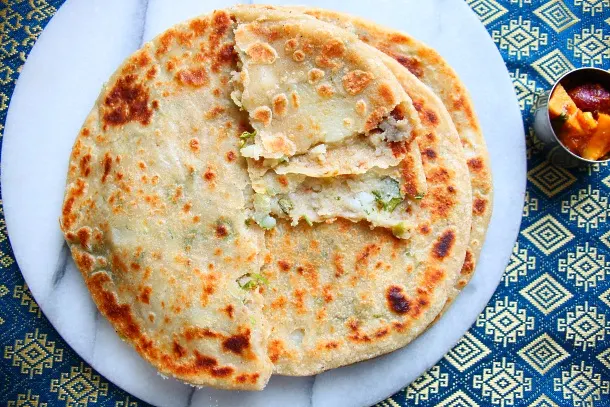I fell in love with paratha at the age of four, when I was the proud owner of various miniature kitchen utensils that looked like they’d been manufactured in toy town. I’d use my hot pink chapatti board and rolling pin to make baby paratha, which my mum would cook and my pa would wolf down with gusto, whilst telling me I was a great chef.
And that was all it took – I had discovered my love of Indian breads. Forget your typical puff of glitter – for this strange little Indian Barbie, childhood was all about that magical cloud of chapatti flour.
Indian breads, without a doubt, are perceived as the fiddliest things to make at home, especially if you’ve never done them before. Aloo Paratha are made by stuffing mashed, spiced potatoes and onions into chapatti dough and rolling so that the dough envelopes the layer of filling inside. Then they’re lightly sizzled in ghee, butter or oil until golden all over. Once cooked, the filling will remain enclosed in the crisp bread until broken open and then the soft, aromatic filling is revealed in all its glory. In my opinion, they’re one of North India’s finest creations.
These spicy potato breads make for a satisfying meal at any time of the day, although they’re more commonly eaten for breakfast. People all over India enjoy their stuffed paratha with a mug of steaming chai, a dollop of plain yogurt and a spicy chutney or curry. In other words, the pairing possibilities are endless.
So next time, before you reach for the dry, unsatisfying, supermarket naans, think about making these super-simple, Punjabi-style paratha. As the famous Gujarati saying goes, ‘Khakhra ni khiskoli sakar no swaad su jaane?’ (‘A squirrel who eats dried chapattis would not know the taste of sugar.’)
The scoop on paratha
Paratha are popular all over the Indian subcontinent; they come in many variations and have lots of different names. Here are a few popular ones:
Plain paratha: Made using chapatti flour, these unstuffed (but not always unflavoured), flaky flatbreads are made by spreading rolled dough with ghee, folding over and rolling again. The process is similar to making homemade puff pastry.
Stuffed paratha: One of the most loved of all, this variety covers all paratha with fillings, including Aloo Paratha. We’ll take a look at some of the most popular flavours later.
Parotta or barotta: The South Indian equivalent and the most fun to eat by far. These are made in a similar fashion to plain paratha but have a multitude of ‘twisted’ layers which can be pulled apart to reveal yet more buttery layers.
Roti canai: A popular Malaysian street food of Indian influence. Unlike the dough of its unleavened Indian cousin, the Malay version is made using eggs and is allowed to proof before being cooked. The result is a light, crispy flatbread with a fluffy middle.
Fill me in
Some of the best-loved stuffed paratha fillings include:
Aloo palak paratha – Spicy mashed potatoes and spinach
Gobi paratha – Creamy cauliflower laced with turmeric
Mooli paratha – Grated peppery daikon radish
Mattar paratha – Crushed green peas and garlic
Paneer paratha – Rich Indian cheese
Keema paratha – Fiery minced meat
Pyaz ka paratha – Sweet and spicy sautéed onions
Methi paratha – Deliciously powerful fenugreek leaves
Sweet paratha – A sprinkling of sugar and maybe a pinch of ground cardamom
With this versatile bread, the flavour combinations are endless and you’ll only be limited by your imagination. As long as the filling is smooth enough to encase in dough and has been flavoured with plenty of spice, it just isn’t possible to run out of bright ideas.
Aloo Paratha
Makes 10-15
Ingredients for the filling:
550g potatoes, boiled, peeled and mashed until smooth
1 large onion, pureed
2 green chilles, minced
40g frozen peas, cooked and coarsely pureed (optional)
1 clove garlic, minced
1 tbsp ginger, minced
1 tsp cumin seeds
1 tsp ground coriander seeds
½ tsp ground cumin seeds
½ tsp garam masala
1 tsp salt
Zest ½ lemon
1 tbsp sunflower oil
Handful fresh coriander, chopped very finely
For the dough:
400g chapatti flour
80ml sunflower oil
Around 200ml hot water
Extra ghee or oil to cook the paratha
Method:
-
To make the filling, heat the oil in a large non-stick pan. Add the cumin seeds, ginger, garlic, chillies and onions. Cook on a medium heat for 5 minutes or until very soft. Add the ground coriander seeds, ground cumin seeds and garam masala. Sauté for a few minutes and add the rest of the ingredients. Combine and cook for a further 5 minutes stirring all the time. Remove from the heat and set aside.
-
To make the dough, take a large bowl and add the chapatti flour. Make a well in the centre and add the oil. Stirring with a spoon, slowly mix in enough hot water for you to be able to to form a dough. When cool enough to handle, bind until you get a soft and smooth, non-sticky dough. If it’s sticky, add a little bit more oil and a dusting of flour and continue to bind.
-
Take a ball of dough, slightly larger than a golf ball, and a larger ball of the cooled potato filling.
-
Roll the dough to about 3-4” in diameter and place the potato ball on top. Using your thumbs and forefingers, pinch the dough closed around the filling, starting in the middle and working your way outwards. The filling wrapped in dough should be fully enclosed with no gaps or holes.
-
Flatten the ball using the palm of your hand. Dust with flour on both sides and flip over. You will need to roll the smooth side.
-
Begin rolling the dough, turning gently as you do. Ensure it is even all over and dust with more flour if necessary. Try to aim for 1/2cm in thickness.
- Heat some oil or ghee in a non-stick frying pan and carefully slide in the paratha. Cook on a medium heat on both sides until golden brown all over, adding more ghee or oil to the pan for added indulgence.
So as if by magic, you’re now a paratha extraordinaire and well on your way to rustling up some bread to accompany your favourite Indian dishes. Enjoy making these traditional Punjabi Aloo Paratha and once you get the hang of rolling, remember to have fun creating your own fillings and flavours.




Super Soft Roti Recipe - Sanjana.Feasts - All Recipes
Wednesday 26th of January 2022
[…] Aloo Paratha recipe Stuffed paratha with potatoes Potato paratha […]
Munch an Indian brunch… in your own home | Culinary Adventures of The Spice Scribe
Thursday 3rd of March 2016
[…] plating, but don’t just look – cook! Keep carbs firmly on the menu, and say hello to aloo parathas, mini masala dosa, and masala pooris served alongside heaping helpings of Gujarati potato-cashew […]
Naz
Monday 3rd of September 2012
I love aloo parathas with mango chutney!
bawa
Thursday 9th of February 2012
We had a cook for many years who did what only my mum can do: get an amazing amount of even filling in the paratha so that it is thick with stuffing and dough is really thin!
One thing I have always noticed in all recipes - both books and internet- is that the rolled out paratha is put straight away into heated oil. Whereas in I have always been taught to cook the paratha like a chapati (no oil) and once it is beginning to get the brown spots on the second side, to then add oil to shallow fry it. This way, the paratha does not absorb so much oil and it really crispy.
You have covered the flavours pretty well, I can only think of paratha that is made by making the dough using left over moongi-masur dal and some chopped onions. Then carry on as for plain parathas. Very tasty!!
mustardseed
Saturday 3rd of December 2011
Love these aloo parathas! You have lovely pictures on your blog and I love your gujarati recipes